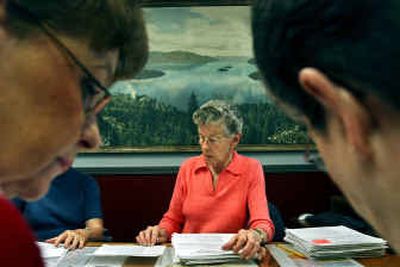Sandpoint split on height limits

Sandpoint residents appear split on the question of where, if anywhere, the city’s building-height restrictions should be eased.
Voters in Sandpoint trickled into City Hall last week to cast their ballots in an advisory election on the question of building-height limits.
The results Monday showed a slight majority in favor of allowing taller buildings in the area of Harold’s IGA, where Panhandle State Bank wants to build a four-story headquarters.
Voters also indicated they are willing to allow the construction of buildings taller than 45 feet on the site of the former Louisiana-Pacific sawmill, which is now a giant, barren lot along North Boyer Avenue.
But they rejected the idea of allowing taller buildings in two areas on the west end of town – around the former Northern Lights building and west of the Federal Building.
The results of the vote are nonbinding, and the City Council is expected to vote on the matter at its Wednesday meeting. Before the council is a proposed ordinance that would allow developers to apply for a conditional use permit to exceed the city’s 45-foot height limit in those four commercial areas of the city. The permits would still cap building heights at 60 feet.
When the issue initially was raised, one citizen delivered a petition with about 450 signatures stating opposition to lifting the height limit to the city’s Planning and Zoning Commission.
Members of the business community are expected to deliver a petition to the council Wednesday in support of the proposed ordinance, characterizing it as a way to maintain jobs in the community.
Panhandle State Bank wants to build a headquarters on the city block bordered by Fifth Avenue, Church and Oak streets. The new building would allow the bank’s administrative offices to be housed in one place and make some room for growth.
The bank’s project also would include leased units for other commercial and retail uses, a high-tech community meeting center, a cafeteria, a four-story atrium and two stories of residential units to help pay for the parking garage beneath the building.
Out of 812 votes cast, 428 ballots were in favor of raising height limits on that block and adjacent blocks to the southwest, and 384 were opposed.
Panhandle State Bank CEO Curt Hecker said he was happy with the results.
“I’m pleased the city was able to get all the votes they did, and it will give the council the ability to really know where the people really stand,” he said.
Opponent John Elsa said the results are not all that clear-cut: “It shows the town was equally split … it’s still going to be up to the City Council.”
Among the supporters for the relaxed height limitations was the Downtown Business Association, which had a few conditions for its support – such as the inclusion of additional design considerations to preserve views and the downtown’s historic character.
“The (bank’s) proposal that’s on the board is a very responsible proposal for the area,” said Pierre Bordenave, president of the association.
“Also on the council’s agenda Wednesday is a proposed resolution to create an Urban Renewal Agency and district to generate tax dollars for new public infrastructure in certain parts of Sandpoint.
The proposed district would include both of the commercial neighborhoods that city residents designated as appropriate for taller buildings. The resolution also names the area west of the Sandpoint Airport along Great Northern Road as part of the district.
In an urban renewal district, tax receipts that are collected on the increased property values generated from development are used to pay for public infrastructure within that district. An improved Great Northern Road is one item on the list of needs in the proposed district. New sewer and water lines, bike paths, sidewalks and other improvements could be funded through the district’s tax revenues.